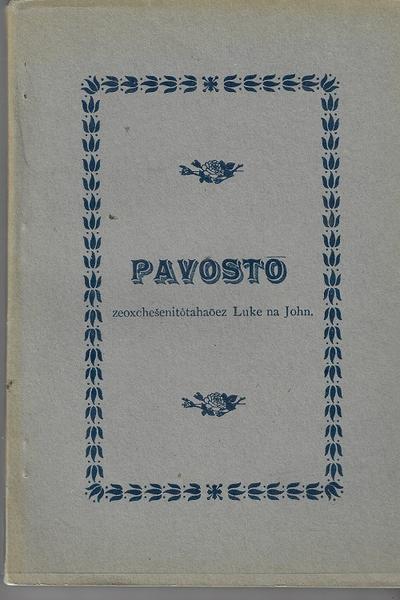NATIVE AMERICAN LINGUISTICs – CHEYENNE LANGUAGE

NATIVE AMERICAN LINGUISTICs – CHEYENNE LANGUAGE Petter, R (ydikoge Charles). PAVOSTO. ZEOXCHESENITOTAHAOEZ LUKE NA JOHN NIS HEVOVISTOMOSSEON JESUS CHRIST. THE GOSPELS OF LUKE AND JOHN TRANSLATED IN THE CHEYENNE LANGUAGE AND PRINTED FOR THE INTEREST OF THE MENNONITE MISSION AMONG THE CHEYENNE INDIANS. Witness Print. 1902. 1st. Rodolphe Charles Petter: a missionary with the General Conference Mennonite [GCM]) to the Cheyenne Native Americans in Oklahoma and Montana; was born 19 February 1865, at Vevey on Lake Geneva, Switzerland. He attended the local and other schools and the Basel Missionsschule (1883-89). While in military training he became acquainted with a Mennonite, Samuel Gerber, visited the Jura Mountain Mennonites, and heard about the mission interest of the Mennonites in America.J.A. Sprunger of Berne, Indiana, who was on a tour of the Swiss Mennonite churches,suggested that he consider work among Native Americans. Soon he and his wife landed in New York to become missionaries to the Cheyenne under the mission board of the General Conference Mennonite Church. They spent the year 1890-91 at Oberlin College, Ohio, and in 1891 began their work at Cantonment, Oklahoma. After his first wife's death he married Bertha Elise Kinsinger, of Trenton, Ohio, in 1911, who was also a missionary to the Cheyenne. In 1916 the Petters took over the Cheyenne mission field at Lame Deer, Montana, where they were active until his death on 6 January 1947.
Petter was one of the most outstanding missionaries and linguists working among Native Americans. He created a dictionary of the Cheyenne language, reduced the Cheyenne language to writing, produced a grammar, and translated Bunyan's Pilgrim's Progress, portions of the Old Testament, and the entireNew Testament. He became a nationally known ethnologist, and his numerous works are found in all leading libraries in this field. His reports about his mission work were published primarily in Christlicher Bundesbank and The Mennonite.
Since neither of them spoke much English, they were asked to spend the winter in Oberlin, Ohio, attending classes at the college and seminary. In the spring of 1891 they were called to Halstead, Kansas, where the Mission Board was meeting. Together with several board members they made a visit to the Oklahoma mission stations at Darlington and Cantonment. That fall they were ordained as missionaries at the Halstead Mennonite Church and from there they arrived in Cantonment, Oklahoma on October 1, 1891. They lived in quarters at the Cantonment Mission School where "he could give his undivided attention and time to the learning of the Cheyenne language and visiting the Indians in their villages and lodges." A large Cheyenne camp was near the mission school, so it became easy for us to be in constant contact with the Indians." Petter continues, "We were deaf and dumb among them, for of the languages we knew was none they understood. Only pantomimes or gesticulations made it possible to get what was wanted. The Cheyenne language was then unwritten, so the sounds had first to be given letters before words could be written. When the latter could be put on paper, they had to be tested over and over to assure they were correctly written. This necessitated close attention and continual contact with the Indians in their villages and lodges, where we were from morning till late in the day, until all the Cheyenne sounds were fixed and words could easily be written down. The collecting of words and sentences had often to be done by pointing the finger to people, objects, and surroundings. In the evening the gathered material was sifted and arranged, to be read to the Indians the next day. This was repeated, corrections made, until the Indians could readily understand what we read to them. After a time a large amount of words and short sentences was thus collected; but it was like a pile of building material, out of it was to come the structure of the language and late in the day, until all the Cheyenne sounds the final use of the same to bring God's message to the Cheyenne in their own tongue."
In 1916, Petter made his fourth trip to Montana as he had been called by the Mission Board to occupy the Lame Deer station. It is here at lame Deer where he completed the translations of the Cheyenne New Testament, portions of the Old Testament and songs.
Quite rare on the market with no copies appearing in auction records. Vg cond. Sources: MENNONITE LIFE - June 2006. Busenitz, Willis: RODOLPHE CHARLES PETTER, LINGUIST.; GLOBAL ANABAPTIST MENNONITE ENCYCLOPEDIA ONLINE; Ayer, Cheyenne 4 (later ed.)

